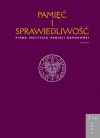Lwowski sobór 8–10 marca 1946 roku: przygotowania, przebieg i skutki. Rola systemu totalitarnego
Lviv Assembly (8–10 March 1946): Preparation, Course and Consequences. The Role of the Totalitarian System
Author(s): Jarosław StockiSubject(s): History
Published by: Instytut Pamięci Narodowej
Summary/Abstract: After the liberation of the western Ukraine from the occupation of the Third Reich, Stalin’s Communist regime has launched a broad attack on Catholicism, especially on its factions, as the Roman Catholic Church, the Armenian Catholic Church and the Ukrainian Greek Catholic Church, which dominated the religious life in Lviv, Stanislavsky, Drogobych and Ternopil regions. RCC (Roman Catholic Church), in particular, has reduced its presence tenfold (from more than 400 parishes in Lviv Archdiocese in 1944 to less than forty – in the late 1946, through the deportation of Poles from Ukraine and Ukrainians from Poland in 1944–1946) in the region. ACC, as an institution, was completely annihilated by the Bolshevik regime in 1945, by the so-called attempted revival of free Armenia. UGCC (Ukrainian Greek Catholic Church), which included about 2300 religious communities, and which had great influence on public life of the Ukrainian western regions, formed their patriotic consciousness, and therefore did not fit in the Bolshevik plan of “sovietization” of the Ukrainian population in the mentioned areas. Therefore the NKVD (People Commissariat for Internal Affairs) and the Bolshevik party elite decided to eliminate UGCC as an institution. The Council for Russian Orthodox Church in Sovnarcom Soviet Union and the Council for worship at Sovnarcom USSR developed a plan for the acquisition of parishes by the Russian Orthodox Church. This plan included: the elimination of monasteries, repression of the hierarchy, clergy, monks, which would prevent the so-called reunification of UGCC with ROC. In May 1945, especially for this last point, the so-called Initiative Group was established (with the direct assistance of the NKVD and referred to as the Soviets). It was led by some leaders of the Greek Catholic priests, who had subsequently carried out this reuniting action. This group has been actively promoted by the local provincial councils, authorized for ROC and for religious worship, as well as functionaries of the provincial offices of the NKVD and Orthodox bishops. In October 1945, as a result of the abovementioned joint actions of these institutions, nearly 800 priests of 1259 – agreed to the reunification. The danger of arrest, deportation of families to Siberia, prison by the NKVD of the Church hierarchy, together with Metropolitan Joseph Slipy and others – these were the reasons, which forced the majority of the Church to reunite. However, the Greek Catholic parishes did not feel such dangers, therefore only 9 of the 2286 religious communities passed to ROC till the end of 1945, so the community waited. To put the fag end in the annihilation of UGCC (Ukrainian Greek Catholic Church), the leadership of the Union of the above-mentioned Councils decided to organise the Assembly, which should be prepared by the Initiative Group, pro-orthodox reunited clergy and the Moscow Patriarchate.
Journal: Pamięć i Sprawiedliwość.
- Issue Year: 14/2009
- Issue No: 1
- Page Range: 237-267
- Page Count: 31
- Language: Polish

